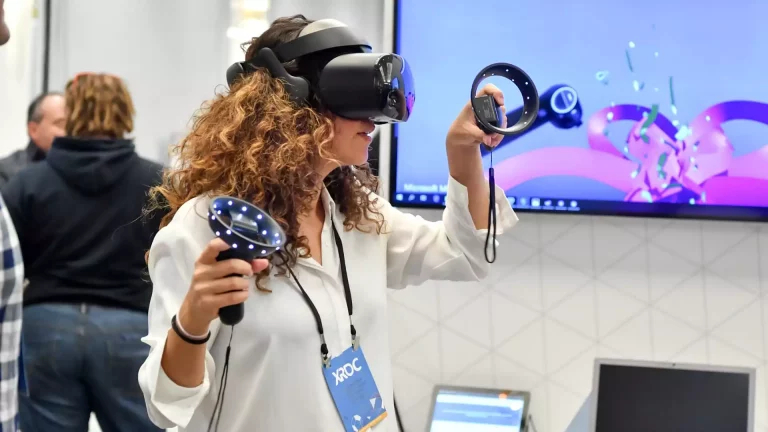
VR continues to reshape how businesses connect with audiences, blurring the lines between the real and digital worlds. VR holds the potential to revolutionize not only how we perceive and interact with the digital realm but also how businesses make their mark in the physical world.
VR immerses users in computer-generated environments through headsets, haptic feedback devices, and motion sensors. It transforms traditional experiences, allowing users to step into a 3D digital world, interact with objects, and even communicate with others in the virtual realm. The technology has moved from sci-fi to a powerful tool for education, entertainment, and trade show engagement.
Navigating the Trade Show Booth
Trade shows are events where businesses from various industries showcase their products and services. Booths are individual setups within these events where companies present their offerings to capture attendees’ attention and interest.
These exhibitions serve as a bustling marketplace for networking, showcasing innovations, and forging connections with potential clients, partners, and customers — including VR technologies.
Introduction to the VR Marketing Advantage
Virtual reality marketing is a forward-looking strategy that harnesses immersive technology to create engaging brand sessions. VR marketing is a potent tool for boosting brand awareness. Creating memorable and shareable experiences elevates a brand’s visibility and sets it apart in crowded markets. It’s particularly effective at trade shows, events, and virtual advertising placements.
Attendees at trade shows or users in virtual advertising spaces are likelier to remember and discuss their encounters, extending the brand’s reach far beyond the initial engagement. The emotional impact of virtual reality can also lead to increased brand loyalty and advocacy as customers become more connected to the brand’s story and values.
Planning for Success
Incorporating virtual reality into your promotion plan is a strategic move that requires careful consideration and planning. Here are some essential steps to fully leverage the potential of VR marketing into your promotional strategy:
- Set clear objectives: Start by defining your marketing goals—whether enhancing brand visibility, boosting lead generation or driving customer engagement. Having well-defined objectives is essential.
- Budget allocation: Determine the estimated costs for each marketing activity within your plan, including expenses for content creation, hardware, software and promotional efforts. Ensure your budget aligns with your goals and the quality of VR experiences you aim to provide.
- Financial impact analysis: Incorporate these budgeted costs into your 12-month cash flow projection to allow you to assess how these expenses will affect your overall financial health and when they will occur throughout the year.
- Advertising break-even analysis: For each marketing tactic, calculate the sales levels required to cover your costs and achieve an advertising break-even to help you understand at what point your investments will start generating a positive return on investment (ROI).
Crafting Immersive Experiences
Crafting immersive experiences in VR is an art form that transcends the boundaries of conventional marketing. Haptic feedback helps with this by allowing you to see and hear your surroundings and feel what’s happening, weaving a digital tapestry that envelops your audience in a world of your design.
Understanding your target demographic’s preferences, interests and behaviors is the key to creating experiences that resonate. Whether your audience comprises tech enthusiasts, adventure seekers or business professionals, the content you develop should cater to their unique tastes.
Immersive experiences transport users into captivating narratives such as a journey through a virtual museum showcasing your brand’s history or an adventure that unfolds in the heart of your creation. The result of these experiences is your audience doesn’t just observe your brand — they become an integral part of it.
Maximizing Engagement
Tap into the competitive spirit of your audience by incorporating gamification into your strategy. Create challenges, contests, or virtual scavenger hunts that encourage attendees to explore your booth and interact with your brand.
You can also bring your presentations to life with live VR demonstrations. Interactive product demonstrations are powerful tools for your marketing plan. Whether it’s a product launch or a behind-the-scenes tour, live sessions add an element of excitement, making your booth a must-visit destination.
These interactions go beyond traditional demos, allowing users to enter your world to explore and engage with your products actively. You can provide hands-on encounters that are both informative and engaging.
Measuring Success
Utilize VR analytics to track user engagement, popular interaction points, and overall booth traffic. This data provides valuable insights into attendee preferences and helps fine-tune future experiences.
After the event, gather feedback from attendees who experienced your VR offerings. What did they love? What could be improved? Incorporating this feedback into your strategy ensures continuous enhancement.
VR Today
It’s clear that we’re on the brink of a marketing transformation. The future is now and it’s virtual. VR marketing turns your brand’s story into an immersive journey and your audience becomes a vital part of the adventure.
 Devin Partida is Editor-in-Chief of Rehack and editorial contributor at AR Insider. See her work here and follow her @rehackmagazine.
Devin Partida is Editor-in-Chief of Rehack and editorial contributor at AR Insider. See her work here and follow her @rehackmagazine.






